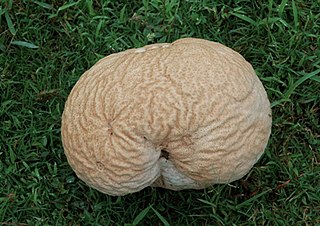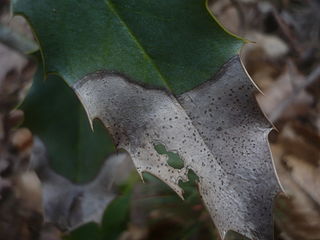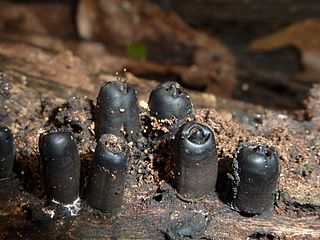
The Russulales are an order of the Agaricomycetes,. According to the Dictionary of the Fungi, the order consists of 12 families, 80 genera, and 1767 species. According to Species Fungorum, the order contains 13 families, 117 genera, and 3,060 species.

The fungal order Agaricales, also known as gilled mushrooms or euagarics, contains some of the most familiar types of mushrooms. The order has 33 extant families, 413 genera, and over 13000 described species, along with six extinct genera known only from the fossil record. They range from the ubiquitous common mushroom to the deadly destroying angel and the hallucinogenic fly agaric to the bioluminescent jack-o-lantern mushroom.

Lepiota is a genus of gilled mushrooms in the family Agaricaceae. All Lepiota species are ground-dwelling saprotrophs with a preference for rich, calcareous soils. Basidiocarps are agaricoid with whitish spores, typically with scaly caps and a ring on the stipe. Around 400 species of Lepiota are currently recognized worldwide. Many species are poisonous, some lethally so.

Calvatia is a genus of puffball mushrooms that includes the spectacular giant puffball C. gigantea. It was formerly classified within the now-obsolete order Lycoperdales, which, following a restructuring of fungal taxonomy brought about by molecular phylogeny, has been split; the puffballs, Calvatia spp. are now placed in the family Agaricaceae of the order Agaricales.

Trametes is a genus of fungi that is distinguished by a pileate basidiocarp, di- to trimitic hyphal systems, smooth non-dextrinoid spores, and a hymenium usually without true hymenial cystidia. The genus has a widespread distribution and contains about fifty species. The genus was circumscribed by Elias Magnus Fries in 1836.

The Tremellaceae are a family of fungi in the order Tremellales. The family is cosmopolitan and contains both teleomorphic and anamorphic genera, most of the latter being yeasts. All teleomorphic species of fungi in the Tremellaceae are parasites of other fungi, though the yeast states are widespread and not restricted to hosts. Basidiocarps, when produced, are gelatinous.

Mutinus is a genus of fungi in the family Phallaceae. The genus was first described by Elias Magnus Fries in 1849. According to the Dictionary of the Fungi, the widespread genus contains 12 species.

Urnula is a genus of cup fungi in the family Sarcosomataceae, circumscribed by Elias Magnus Fries in 1849. The genus contains several species found in Asia, Europe, Greenland, and North America. Sarcosomataceae fungi produce dark-colored, shallow to deep funnel-shaped fruitbodies with or without a stipe, growing in spring. The type species of the genus is Urnula craterium, commonly known as the devil's urn or the gray urn. Urnula species can grow as saprobes or parasites having an anamorphic state. The anamorphic form of U. craterium causes Strumella canker, on oak trees.

Trochila is a genus of fungi in the family Dermateaceae. It was circumscribed by Elias Magnus Fries in 1849. The genus contains 15 species.

Camillea is a genus of fungi in the family Xylariaceae. Collectively, the 41 species in the genus have a widespread distribution, but are especially prevalent in tropical areas. Fruit bodies of Camillea species tend to be cylindrical in shape. The genus was originally circumscribed by Swedish mycologist Elias Fries in his 1849 work Summa vegetabilium Scandinaviae.

Kretzschmaria is a genus of fungi in the family Xylariaceae. The genus, circumscribed by Swedish mycologist Elias Magnus Fries in 1849, contains about 30 species that collectively have a widespread distribution.

Collybia is a genus of mushrooms in the Tricholomataceae family. The genus has a widespread but rare distribution in north temperate areas, and contains three species that grow on the decomposing remains of other mushrooms.

Montagnea is a genus of fungi in the family Agaricaceae. The genus has a widespread distribution in subtropical dry areas, and contains five species. Montagnea was circumscribed by Swedish mycologist Elias Magnus Fries in 1836.

Valsa is a genus of fungi within the Valsaceae family. There are about 70 species in the widespread genus. Anamorphs are classified in the genus Cytospora.

Clavaria is a genus of fungi in the family Clavariaceae. Species of Clavaria produce basidiocarps that are either cylindrical to club-shaped or branched and coral-like. They are often grouped with similar-looking species from other genera, when they are collectively known as the clavarioid fungi. All Clavaria species are terrestrial and most are believed to be saprotrophic. In Europe, they are typical of old, mossy, unimproved grassland. In North America and elsewhere, they are more commonly found in woodlands.

The gasteroid fungi are a group of fungi in the Basidiomycota. Species were formerly placed in the obsolete class Gasteromycetes Fr., or the equally obsolete order Gasteromycetales Rea, because they produce spores inside their basidiocarps rather than on an outer surface. However, the class is polyphyletic, as such species—which include puffballs, earthstars, stinkhorns, and false truffles—are not closely related to each other. Because they are often studied as a group, it has been convenient to retain the informal (non-taxonomic) name of "gasteroid fungi".

















